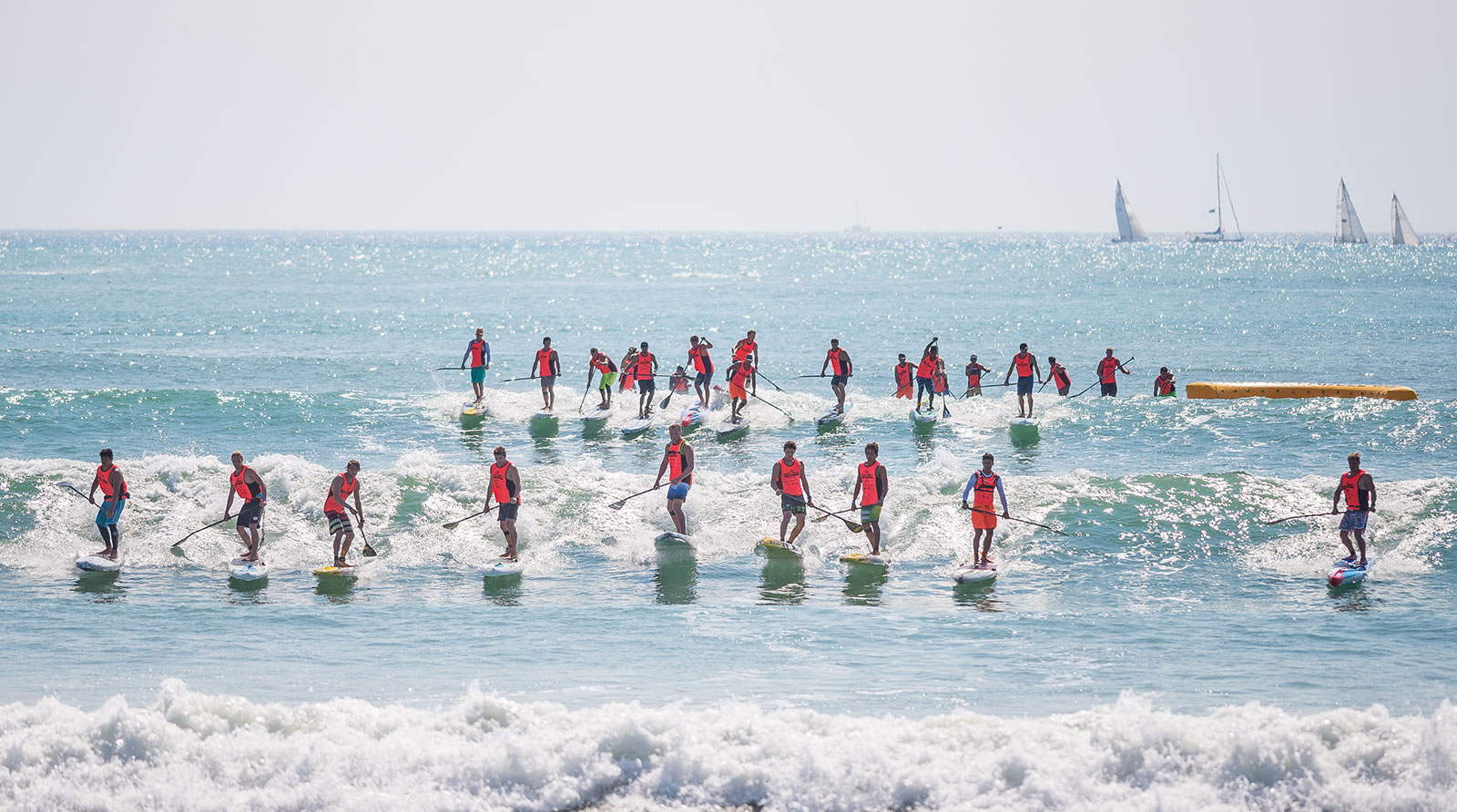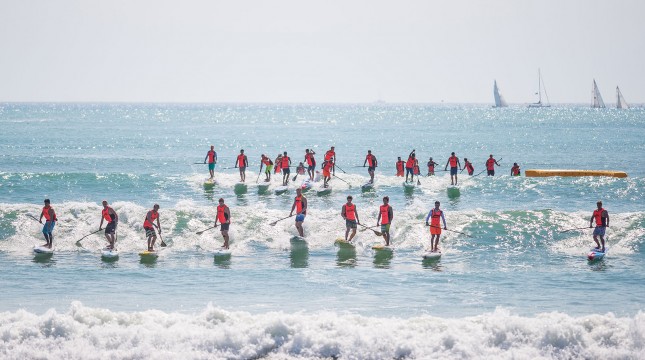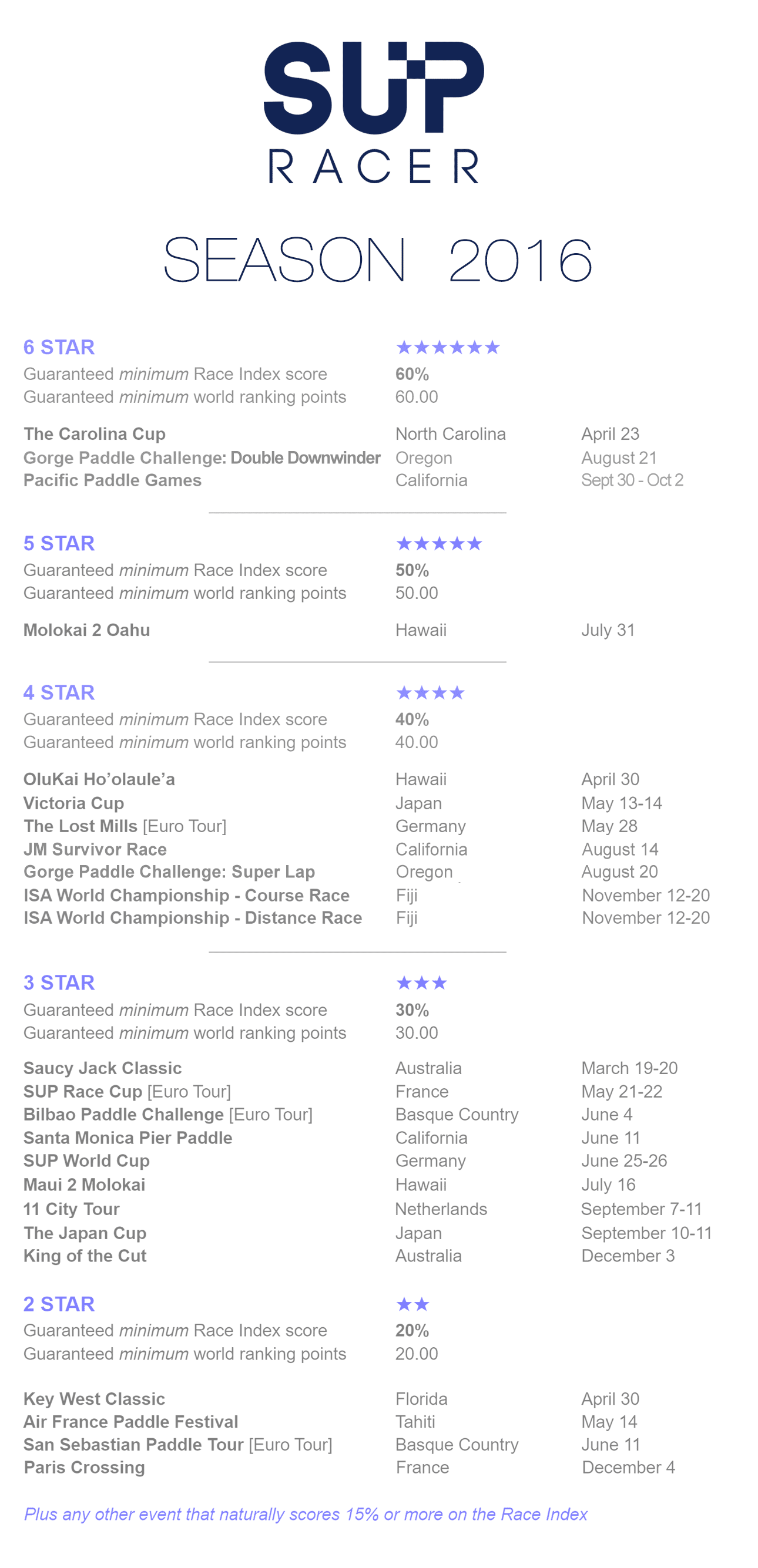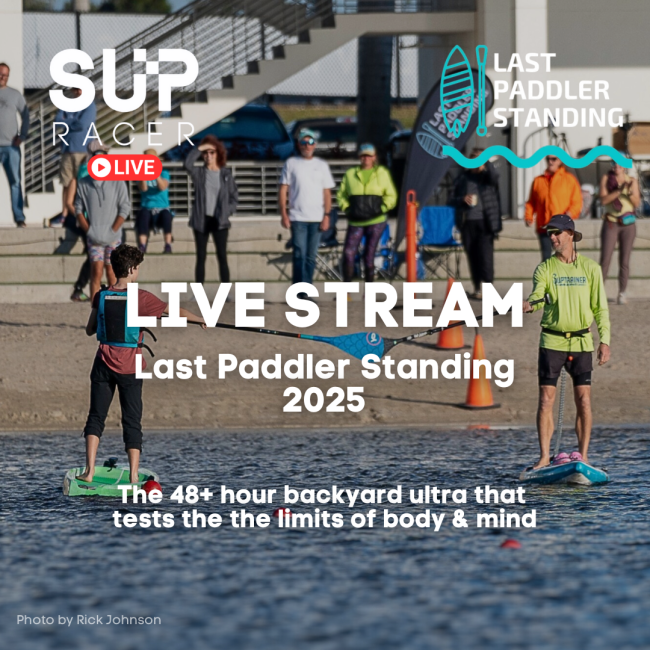
Changes to the World Rankings and Race Calendar in Season 2016

The Pacific Paddle Games, one of the biggest races of the season (photo: Welker/SUP Racer)
I want to share some changes we’re making to both the SUP Racer World Rankings and our Race Calendar, which will hopefully make the sport easier to follow for the the fans, the brands, the events, the sponsors, and, most importantly, the athletes themselves.
The basic goal is to give the international race season a bit more structure, while also evolving the rankings system to ensure it’s as accurate and interesting as possible.
The short version: All of the big international races in season 2016 will receive guaranteed minimum points on the Race Index, so that everyone knows in advance which events will definitely count towards the world rankings. The star ratings on our Race Calendar have been aligned with the Race Index to keep things consistent across the site.
(Only international level events are given star ratings — all others are now simply listed as either ‘local’ or ‘regional’ races.)
For example: Based on its past performance and expected level of elite competition this year, the big Lost Mills race in Germany has been awarded a guaranteed minimum Race Index score of 40%, which means there are at least 40.00 world ranking points on offer for the winner; Therefore the race is now listed as a 4-star event on the Race Calendar.
As a quick refresher: SUP Racer’s custom-built Race Index formula, which is the basis of the world rankings system, scores every event around the world from 0-100% based on the elite level of competition on the start line; The higher the level of competition, the more an event is worth and the more world ranking points on offer to the athletes.
Click here to jump straight to the full list of star-rated events that have earned a guaranteed minimum Race Index score in season 2016.
Ok so that’s the short version. The long version, well, take a deep breath…
I started working on the SUP Racer World Rankings system four years ago. Over nearly 18 months I built this system from scratch into the basis of what you see today. After the basic system was built, I ran a “shadow” world rankings behind the scenes for 12 months to refine the system before it went public. On the eve of the 2014 Battle of the Paddle, the inaugural world rankings Top 100 Men and Top 50 Women leaderboards were released.
Since then, the World Rankings have taken on a life of their own. I honestly never expected them to become so popular. I’m a total stats geek and I created the rankings pretty much for my own amusement more than anything, but apparently I’m not the only one who really loves this sport.
Not everyone follows the rankings of course. Some athletes base their season around it while others couldn’t care less. But with so much volatility and fragmentation in this young sport of ours, it seems the SUP Racer World Rankings have become somewhat influential, which means I’ve got a duty to make sure they roll along as smoothly as possible.
The SUP Racer World Rankings are only one small part of a much larger stand up paddling ecosystem. And the world rankings are not a “world tour,” they’re just a world rankings. Could this system be the basis for something more refined in the future? Sure, but for now it’s just a window into the sport — I’m simply sitting on the sidelines letting everyone know who’s performing best out on the field.
It takes a lot of work to maintain the world rankings. The back-end spreadsheet database contains more than one million cells. It’s mind-boggling to look at the damn thing, but fortunately I’ve been able to automate the process more and more over time in order to keep my sanity. It still takes a few hours to do each update, but it’s not ‘work’ when you love what you’re doing — I’d gladly spend all day playing with stats and numbers, so I’ll continue updating and improving this system no matter how much time or effort it requires.
I look at the rankings as a fluid, ever-evolving beast that by its very nature will never be perfect. I’m proud of what I’ve created with this system — there are very few sports that use such an algorithmic, in-depth rankings formula – but I’m also the first to admit the system has a few flaws. For one, some events are underscored, while the original system didn’t make it very easy for athletes and team managers to plan their season because our proprietary “Race Index” formula only scored races after they were finished.
Or in other words: In the past, nobody, not even me, knew for sure which races would count towards the SUP Racer World Rankings until after those races had already finished. This was both a pro and a con: It ensured the system was based purely on the numbers, not my personal biases or opinions, but it also made it very difficult to follow, not only for the athletes but also the fans, the brands, the events, the sponsors, etc.
So earlier this year I set about improving the system and making it as accurate and entertaining as possible for the athletes, the brands, the events, the sponsors, the media, and the fans; For everyone in the sport.
Over the past four months I’ve been speaking one-on-one with more than 150 leading athletes, race directors, brand managers, sponsors, media figures and other influential members of the stand up paddling community. I started sharing the draft changes as early as January, and over the next few months I listened to a lot of very helpful feedback and constructive criticism.
(Being the stats geek I am, I kept a meticulous record of exactly who I shared the draft changes with: 47 of the top 50 ranked men, 22 of the top 25 ranked women, 23 significant race directors, and 67 brand owners, team managers, media figures, veteran paddlers, emerging paddlers, and other influential members of the community. There was an 88% response rate, and 94% of respondents either agreed or strongly agreed with the changes.)
Did everybody agree with every minor detail of my final version? Hell no. But I figure if 80% of us agree on 80% of the details, that’s enough. Plus one thing that really stood out to me during this whole process was just how passionate and enthusiastic the SUP community is about our sport.
When I started back in January, I was worried the problem wouldn’t be disagreement, it would be apathy. Does anyone else even care about this stuff? Would anybody bother reading through my draft? The detailed PDF I was sharing was 13 pages, after all. But to my pleasant surprise, I ended up engaging in over one hundred spirited discussions with leading members of the community.
This whole thing has been rather exhaustive but also a lot of fun. The SUP Racer World Rankings has been my pet project, and as anyone who has ever met me and discussed the system will know, I can talk about it all day. Plus being able to speak privately with so many of the incredible athletes and industry figures in our sport is both an honour and a privilege.
So without too much further ado, here’s how the SUP Racer World Rankings and our Race Calendar are going to work this season, and possibly for many seasons to come.
As I said up top, there are a couple of fundamental changes:
1. All big international races will be given a base Race Index score ahead of time, which guarantees that event will count towards the world rankings.
2. The star rating system on our Race Calendar is now aligned with the Race Index, i.e. a 4-star event means the race is worth at least 40% on the Race Index. The Race Index score always correlates with the amount of world ranking points on offer, so in this case the winner would score 40.00 points.
Below is the list of “protected events” that have earned star ratings and guaranteed minimum Race Index scores in season 2016.
The guaranteed minimum Race Index scores are based almost entirely on the expected level of elite competition, however other factors such as regional significance, prestige and influence on the sport in general have also been considered (and sometimes played a small role in bumping up an event’s score).
It’s important to note that the vast majority of these races would have earned these Race Index scores anyway, meaning the rankings will operate very similar to how they did in the past. Events are simply being awarded points in advance to make it easier for everyone to understand.
How do I know which events are going to be “big” ahead of time? It’s easy to look back at the Race Index scores from the past two years, though just to make sure I also asked many of the top athletes for their 2016 season schedules, then went about calculating approximate Race Index scores.
I’ll do a follow up post next week to explain why each race earned the specific star rating I’ve given it (each and every race on this list has thoroughly earned its spot).
It’s also very important to note that these are minimum scores, not set scores. Any event can still produce a higher Race Index score than the guaranteed minimum I’ve already awarded it. For example, the Pacific Paddle Games scored 81.0% last year, and no doubt it will once again attract a strong field this year and score well above it’s 6-star, 60% minimum. These star ratings are a floor, not a ceiling.

Note #1: Yes, some of these events have already happened, so why exactly did I wait until after the season had begun to announce the changes? Firstly, most of the leading athletes/event directors/brands/etc were notified months ago. Secondly, I wanted to wait until more races were confirmed — several big international events were canceled in the past 12 months, and several more may fall over this season, so I didn’t want to jump the gun.
Note #2: Any other event in the world can and will still count for the world rankings if it naturally scores 15% or more on the Race Index, which is the same as how the system worked in the past.
Note #3: More events will be given a guaranteed star rating this year, just as soon as they’re confirmed. Several races in the back half of the season are likely to go ahead but yet to be officially announced: There’s potentially a big new race in the States in August, and another one in September. The World Series hasn’t confirmed the majority of its season, and those races almost always attract an elite field and count for the rankings.
Note #4: This is simply the list for season 2016; the list will be reviewed at the start of each season. Big new events will pop up every year, while established races will sometimes disappear. Established regional events will suddenly mature into international races, while other events might just suddenly start to suck. The races listed above are not “set for life,” and all the other other events are not locked out of the system.
Note #5: Are some events and regions missing? For sure.
There’s nothing from the paddling mecca of Brazil, which I feel is a big hole. New Zealand probably deserves a spot. I’d love to see a “regional major” pop up somewhere like South Africa. Mexico has hosted world class events in the past and surely will again in the future. Canada is maturing as a stand up paddling nation. Plus there are dozens of great events across the United States whose absence people will no doubt question (Hanohano perhaps? Chattajack?). The list goes on, and again, the schedule of events will be reviewed before next season.
Note #6: What about the World Series, does that still count? Yep. And it’s already on the list, at least the two events that have been confirmed so far (the Victoria Pro and the SUP World Cup). The World Series is trying to overcome some serious financial issues right now, which means their traditional events later in the season (Huntington and Turtle Bay, for example) haven’t been confirmed yet. If they do get confirmed, they’ll still count just like they always do. Whatever events the athletes support, SUP Racer will support.
Note #7: We are moving towards “One event, one result” to ensure there is consistency in the rankings. Many events are moving that way anyway (such as the Pacific Paddle Games), while many events that have two separate races also have a logical path towards a “single result,” such as the Saucy Jack Classic, the Gorge Paddle Challenge, and the World Series. And while I don’t think it’s particularly fair to combine performances from two very different races, such as a distance and a sprint, into one single result (because that penalises the athletes that specialise in one particular discipline), I believe this “one event/one result” approach is better than the confusion of having two winners and two sets of results within one single event. In a perfect world, I would really like to see “One event, one race” but until then, this is a compromise.
There are exceptions, such as the ISA Worlds where it’s virtually impossible to combine results (most athletes only do one race or the other). Speaking of the ISA Worlds, I gave those races 50% based on the assumption that women will be allowed to compete on the same level as men in 2016; previously it’s been two guys but only one woman per country per race. With only one woman from each country, the field remains quite shallow and a 50% score might artificially inflate the event’s contribution to the world rankings. But I trust the ISA will heed the community’s advice and introduce gender equality this year.
JULY UPDATE: ISA decides not to introduce gender equality, and therefore gets demoted from 5-star to 4-star.
There is also question marks over whether the Gorge Paddle Challenge will be one or two results this year. It was always two results in the past, but the 2016 event format hasn’t been confirmed yet, and there’s been discussion of focusing more on the Double Downwinder event and less on the elite course race. The Gorge has a slight asterisk on it for now, but I’m pretty sure it’ll become “One event, one result” no matter what exactly the final format looks like.
And in Europe, should the Lost Mills’ “Fastest Paddler On Earth” time trial count as a separate race, as it always has, or should it be removed and viewed simply as an exhibition event? Considering it cannot logically be combined with results of the main event (the distance race), and because it’s an established race in its own right, I’ve decided it will continue to count as a separate result for now, but with a lowered significance to ensure the Lost Mills’ main event is the main event.
UPDATE: The “Fastest Paddler On Earth” is going to be phased out; In 2016 it will count for 20% maximum, and in 2017 it won’t count at all. UPDATE #2: This note explains it better.
Note #8: Finally, as I noted earlier but just to reinforce the point: Almost all of these events above would have scored these Race Index percentages on their own anyway (or at least very close to it), so this is essentially the same system the world rankings used in 2014 and 2015, we’re just awarding points ahead of time.
Hopefully the changes I’m announcing today, which I’ve already shared with many members of our great community over the past four months, will give the international SUP racing season a bit more structure, make the international race season a little easier to follow, and create some more enthusiasm in the sport in general.
This system isn’t perfect and never will be, but I believe the SUP Racer World Rankings contribute significantly to the sport, so I’m thoroughly committed to improving the system every year. This is for the athletes, for the fans, for the brands, for the sponsors, for the media, for the events, and for the sport of stand up paddling in general.
Now stop reading this novel of a post and go have some fun out on the water.
AUGUST UPDATE: Slight changes to the star ratings, with The Japan Cup increased to 3-star, and the JM Survivor Race introduced as a 4-star event.
AUGUST UPDATE #2: Slight changes to the star ratings for the Gorge Paddle Challenge, with the Super Lap set as a maximum 4-star race, and the Double Downwinder set at a minimum 6-star.
AUGUST UPDATE #3: 11 City Tour increased from 2-star to 3-star to recognise the immense challenge of this event. The 11 Cities is one of the very few events that scores a “bonus” star based on factors outside of pure level of competition.




You must be logged in to post a comment.